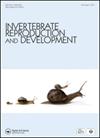中华绒螯蟹幼激素环氧化物水解酶样(EsJHEH-like)的克隆、表达分析及其在法尼酸甲酯代谢中的潜在作用
IF 0.8
4区 生物学
Q4 REPRODUCTIVE BIOLOGY
引用次数: 0
摘要
摘要倍半萜甲基法尼酸甲酯(MF)是一种相当于幼年激素(JH III)的甲壳类动物,在调节甲壳类生物的许多生理过程,特别是卵巢发育和繁殖方面发挥着重要作用。先前的研究表明,甲壳类动物对MF的降解类似于JH III的降解,并且涉及特定的羧酸酯酶。幼激素酯酶水解酶(JHEH)是导致昆虫JH失活的另一种重要酶。本研究在中华绒螯蟹中鉴定并鉴定了EsJHEH样基因的全长cDNA。序列分析表明,EsJHEH-like属于微粒体环氧化物水解酶(mEH)家族,含有几个典型的基序。定量PCR结果显示EsJHEH样蛋白主要在肝胰腺中表达。在卵巢发育过程中,肝胰腺中EsJHEH样mRNA的表达在卵黄生成早期特异性升高,之前的研究报道了血淋巴MF滴度的显著升高,但卵巢中没有显著变化。此外,除胚胎前卵母细胞外,肝胰腺中EsJHEH样表达在每个阶段都明显高于卵巢。此外,EsJHEH样表达在肝胰腺中在体外和体内都被显著诱导,但在卵巢中没有。总之,这些结果表明,类EsJHEH可能是一种参与MF降解的MF水解酶。本文章由计算机程序翻译,如有差异,请以英文原文为准。
Cloning and expression analysis of juvenile hormone epoxide hydrolase-like (EsJHEH-like) from Eriocheir sinensis, and its potential roles in methyl farnesoate metabolism
ABSTRACT The sesquiterpenoid methyl farnesoate (MF), a crustacean equivalent of juvenile hormone (JH III), plays important roles in regulating many physiological processes in crustaceans, especially ovarian development and reproduction. Previous research indicates that degradation of MF in crustaceans is similar to JH III degradation, and involves specific carboxylesterases. Juvenile hormone esterase hydrolase (JHEH) is another important enzyme responsible for JH inactivation in insects. In this study, the full-length cDNA of EsJHEH-like was identified and characterized in Eriocheir sinensis. Sequence analysis showed that EsJHEH-like belongs to the microsomal epoxide hydrolase (mEH) family containing several typical motifs. Quantitative PCR results showed that EsJHEH-like was expressed primarily in the hepatopancreas. During ovarian development, EsJHEH-like mRNA expression in the hepatopancreas was elevated specifically in the early vitellogenic stage, prior to the remarkable rise in haemolymph MF titre reported in previous studies, but no significant changes in the ovary. In addition, EsJHEH-like expression in the hepatopancreas was notably greater than in the ovary at each stage except for previtellogenic oocytes. Furthermore, EsJHEH-like expression in the hepatopancreas was significantly induced in vitro and in vivo, but not in the ovary. Taken together, these results suggest that EsJHEH-like may potentially serve as an MF hydrolase involved in the degradation of MF.
求助全文
通过发布文献求助,成功后即可免费获取论文全文。
去求助
来源期刊
CiteScore
1.90
自引率
0.00%
发文量
21
审稿时长
>12 weeks
期刊介绍:
Invertebrate Reproduction & Development ( IRD) presents original research on the reproductive and developmental biology of the Invertebrata, both embryonic and postembryonic. IRD welcomes papers reporting significant results obtained using new techniques. Encouraged topic areas include: aquaculture, physiology, biochemistry, functional morphology, phylogeny, behavioural and regulatory mechanisms, including genetic, endocrine and molecular studies. Papers containing qualitative descriptions of reproductive cycles and gametogenesis will not be considered. IRD is published in association with the International Society of Invertebrate Reproduction and Development.

 求助内容:
求助内容: 应助结果提醒方式:
应助结果提醒方式:


